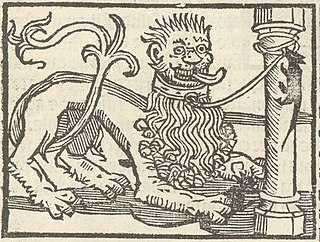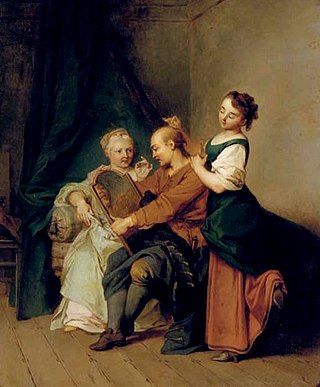
The Wolf and the Crane is a fable attributed to Aesop that has several eastern analogues. Similar stories have a lion instead of a wolf, and a stork, heron or partridge takes the place of the crane.

The Wolf and the Crane is a fable attributed to Aesop that has several eastern analogues. Similar stories have a lion instead of a wolf, and a stork, heron or partridge takes the place of the crane.
A feeding wolf got a small bone stuck in his throat and, in terrible pain, begged the other animals for help, promising a reward. At last the Crane agreed to try and, putting its long bill down the Wolf's throat, loosened the bone and took it out. But when the Crane asked for his reward, the Wolf replied, "You have put your head inside a wolf's mouth and taken it out again in safety; that ought to be reward enough for you." In early versions, where Phaedrus has a crane, Babrius has a heron, but a wolf is involved in both.
The story is very close in detail to the Javasakuna Jataka in the Buddhist scriptures. In this it is a woodpecker that dislodges the bone from a lion's throat, having first taken the precaution of propping its mouth open with a stick. On testing his gratitude later, the woodpecker is given the same answer as the wolf's and reflects on the wisdom of avoiding future harm through association with the violent:
A Jewish Midrash version, dating from the 1st century CE, tells how an Egyptian partridge extracts a thorn from the tongue of a lion. Its reward is similar to the other retellings. Another of this fable's earliest applications was at the beginning of the Roman emperor Hadrian's reign (117–138 CE), when Joshua ben Hananiah skilfully made use of the Babrius variant involving a wolf and a heron in order to dissuade the Jewish people from rebelling against Rome and once more putting their heads into the lion's jaws. [2]

It is notable that both Asian versions are given a political application. This is equally true of John Lydgate's 15th century retelling of Isopes Fabules, titled 'How the Wolf deceived the Crane'. [3] The crane there is described as a surgeon engaged to perform a delicate operation and then deceived out of his fee. Lydgate goes on to draw the wider lesson of how a tyrannous aristocracy oppresses the rural poor and gives them no return for their service.
Jean de la Fontaine makes his social point through satire. In Le loup et la cigogne (Fables III.9) he also describes the crane's action as a surgical service; but when it asks for the salary promised, it is scolded for ingratitude by the wolf. [4] Gotthold Ephraim Lessing takes the satire even further in alluding to the fable in his sequel, "The Sick Wolf". The predator is near death and, in confessing himself to the fox, recalls occasions when he voluntarily abstained from killing sheep. The sympathising fox replies, 'I recollect all the particulars. It was just at that time that you suffered so much from the bone in your throat.' [5] In Ran Bosilek's Bulgarian adaptation, "The Choking Bear", the stork, after being deceived once, takes the precaution of pulling out the bear's teeth before treating its patient again, forcing her to think of an alternative reward. [6]

A political lesson can also be drawn from some mediaeval sculptures of the fable, most notably on the Great Fountain in Perugia executed in 1278 by Nicola Pisano and his son Giovanni. [7] Since Perugia was at that time an ally of Rome, a carving of the wolf suckling Remus is included there; but the wolf peers back over her shoulder towards two adjacent panels depicting the fables "The Wolf and the Lamb" and "The Wolf and the Stork". This hints at the political lesson that the friend might find an excuse to swallow its ally or at the very least would not reward its help. [8]
Where sculptures of the fable are found in a church, a different symbolism is involved. Commenting on its appearance above a capital of the west door of Autun Cathedral, one scholar points out that what is in this instance a fox typifies the devil, and the crane is an emblem of Christian care and vigilance, ever active in saving souls from the jaws of hell. The crane must therefore be imagined as coming to the rescue, not of the fox, but of the bone. [9] This religious meaning made the subject, according to the French architect Eugène Viollet-le-Duc, one of the commonest sculpted on buildings from the 12th to the 13th century, [10] not simply in France, but elsewhere in Europe. The fable appears as one of many animal scenes in the borders of the 11th-century Bayeux Tapestry. [11]
The subject continues to be featured in more modern times, as evidenced by its appearance on the St. Petersburg monument to Ivan Krylov (1855), [12] as a bronze sculpture by Joseph Victor Chemin (1825–1901) in the Musée Jean de La Fontaine, [13] and by Stefan Horota in Berlin's Treptower Park (1968). In Bangladesh, the story is adapted to native species, the tiger and crane or egret, and is found painted on rickshaw panels as illustrated above.

Fable is a literary genre defined as a succinct fictional story, in prose or verse, that features animals, legendary creatures, plants, inanimate objects, or forces of nature that are anthropomorphized, and that illustrates or leads to a particular moral lesson, which may at the end be added explicitly as a concise maxim or saying.

Ivan Andreyevich Krylov is Russia's best-known fabulist and probably the most epigrammatic of all Russian authors. Formerly a dramatist and journalist, he only discovered his true genre at the age of 40. While many of his earlier fables were loosely based on Aesop's and La Fontaine's, later fables were original work, often with a satirical bent.

Aesop's Fables, or the Aesopica, is a collection of fables credited to Aesop, a slave and storyteller who lived in ancient Greece between 620 and 564 BCE. Of varied and unclear origins, the stories associated with his name have descended to modern times through a number of sources and continue to be reinterpreted in different verbal registers and in popular as well as artistic media.

The Fox and the Grapes is one of Aesop's Fables, numbered 15 in the Perry Index. The narration is concise and subsequent retellings have often been equally so. The story concerns a fox that tries to eat grapes from a vine but cannot reach them. Rather than admit defeat, he states they are undesirable. The expression "sour grapes" originated from this fable.
The lion's share is an idiomatic expression which now refers to the major share of something. The phrase derives from the plot of a number of fables ascribed to Aesop and is used here as their generic title. There are two main types of story, which exist in several different versions. Other fables exist in the East that feature division of prey in such a way that the divider gains the greater part - or even the whole. In English the phrase used in the sense of nearly all only appeared at the end of the 18th century; the French equivalent, le partage du lion, is recorded from the start of that century, following La Fontaine's version of the fable.

The Lion and the Mouse is one of Aesop's Fables, numbered 150 in the Perry Index. There are also Eastern variants of the story, all of which demonstrate mutual dependence regardless of size or status. In the Renaissance the fable was provided with a sequel condemning social ambition.

The Dog and Its Reflection is one of Aesop's Fables and is numbered 133 in the Perry Index. The Greek language original was retold in Latin and in this way was spread across Europe, teaching the lesson to be contented with what one has and not to relinquish substance for shadow. There also exist Indian variants of the story. The morals at the end of the fable have provided both English and French with proverbs and the story has been applied to a variety of social situations.
The Cat and the Mice is a fable attributed to Aesop of which there are several variants. Sometimes a weasel is the predator; the prey can also be rats and chickens.

The Mischievous Dog is one of Aesop's Fables, of which there is a Greek version by Babrius and a Latin version by Avianus. It is numbered 332 in the Perry Index. The story concerns a dog that bites the legs of others. Its master therefore ties a bell around its neck to warn people. The dog, thinking the bell is a reward, shows it off in the streets until an older dog reminds him that the bell is not a reward but a sign of disgrace. Victorian editors of the fables supplied the moral that 'notoriety is often mistaken for fame'.

The Farmer and the Viper is one of Aesop's Fables, numbered 176 in the Perry Index. It has the moral that kindness to evil will be met by betrayal and is the source of the idiom "to nourish a viper in one's bosom". The fable is not to be confused with The Snake and the Farmer, which looks back to a situation when friendship was possible between the two.

The Fox and the Crow is one of Aesop's Fables, numbered 124 in the Perry Index. There are early Latin and Greek versions and the fable may even have been portrayed on an ancient Greek vase. The story is used as a warning against listening to flattery.
The Ass in the Lion's Skin is one of Aesop's Fables, of which there are two distinct versions. There are also several Eastern variants, and the story's interpretation varies accordingly.

The Fox and the Sick Lion is one of Aesop's Fables, well known from Classical times and numbered 142 in the Perry Index. There is also an Indian analogue. Interpretations of the story's meaning have differed widely in the course of two and a half millennia.

The Wolf and the Lamb is a well-known fable of Aesop and is numbered 155 in the Perry Index. There are several variant stories of tyrannical injustice in which a victim is falsely accused and killed despite a reasonable defence.

The Fox and the Stork, also known as The Fox and the Crane, is one of Aesop's fables and is first recorded in the collection of Phaedrus. It is numbered 426 in the Perry Index.
The Perry Index is a widely used index of "Aesop's Fables" or "Aesopica", the fables credited to Aesop, the storyteller who lived in ancient Greece between 620 and 560 BC. The index was created by Ben Edwin Perry, a professor of classics at the University of Illinois Urbana-Champaign.

Jean de La Fontaine collected fables from a wide variety of sources, both Western and Eastern, and adapted them into French free verse. They were issued under the general title of Fables in several volumes from 1668 to 1694 and are considered classics of French literature. Humorous, nuanced and ironical, they were originally aimed at adults but then entered the educational system and were required learning for school children.

The Man with Two Mistresses is one of Aesop's Fables that deals directly with human foibles. It is numbered 31 in the Perry Index.
The Fisherman and his Flute appears among Aesop's Fables and is numbered 11 in the Perry Index. Wide variations on the theme have existed over the centuries.

The animals sick of the plague is a dark fable by Jean de la Fontaine about the inequality of justice. It was published in 1678 at the head of his second volume of Fables (VII.1) and is generally considered one of his best.